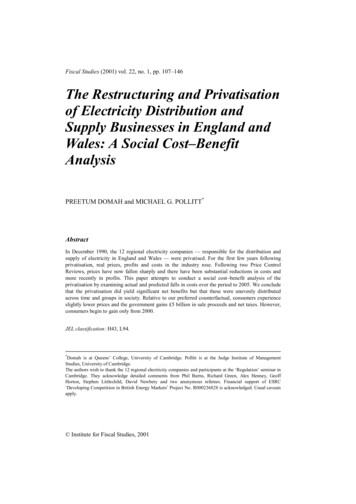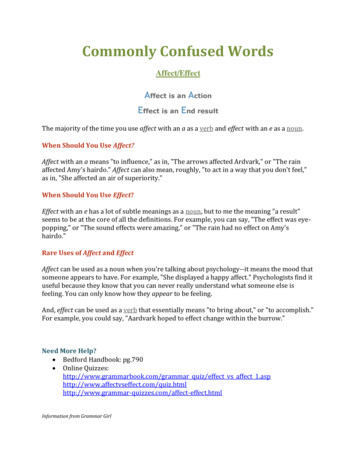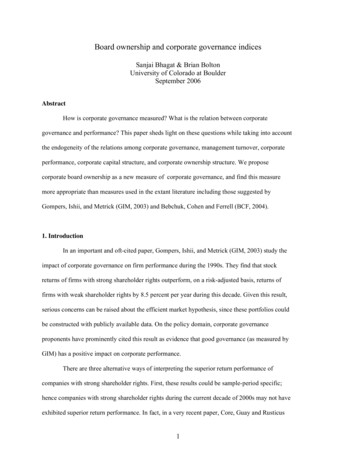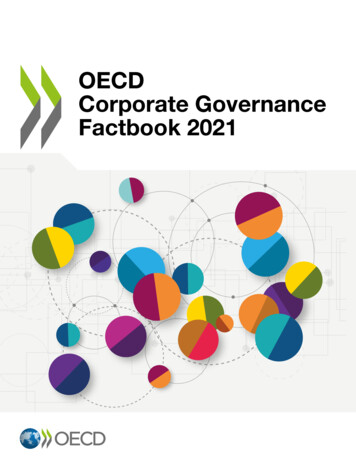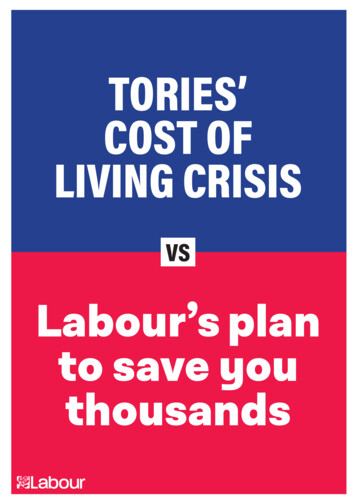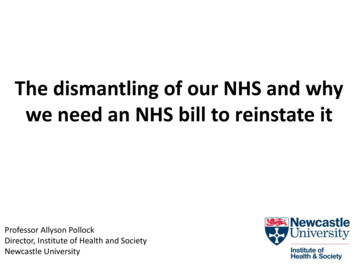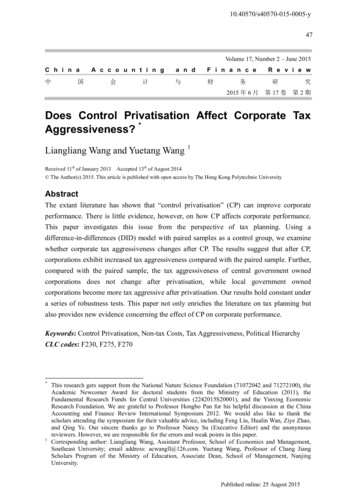
Transcription
10.40570/s40570-015-0005-y47Volume 17, Number 2 – June 2015C h i n a中国A c c o u n t i n g会计a n dF i n a n c e与财R e v i e w务研2015 年 6 月第 17 卷究第2期Does Control Privatisation Affect Corporate TaxAggressiveness? *Liangliang Wang and Yuetang Wang1Received 11th of January 2013 Accepted 13th of August 2014 The Author(s) 2015. This article is published with open access by The Hong Kong Polytechnic UniversityAbstractThe extant literature has shown that “control privatisation” (CP) can improve corporateperformance. There is little evidence, however, on how CP affects corporate performance.This paper investigates this issue from the perspective of tax planning. Using adifference-in-differences (DID) model with paired samples as a control group, we examinewhether corporate tax aggressiveness changes after CP. The results suggest that after CP,corporations exhibit increased tax aggressiveness compared with the paired sample. Further,compared with the paired sample, the tax aggressiveness of central government ownedcorporations does not change after privatisation, while local government ownedcorporations become more tax aggressive after privatisation. Our results hold constant undera series of robustness tests. This paper not only enriches the literature on tax planning butalso provides new evidence concerning the effect of CP on corporate performance.Keywords: Control Privatisation, Non-tax Costs, Tax Aggressiveness, Political HierarchyCLC codes: F230, F275, F270*1This research gets support from the National Nature Science Foundation (71072042 and 71272100), theAcademic Newcomer Award for doctoral students from the Ministry of Education (2011), theFundamental Research Funds for Central Universities (2242015S20001), and the Yinxing EconomicResearch Foundation. We are grateful to Professor Hongbo Pan for his helpful discussion at the ChinaAccounting and Finance Review International Symposium 2012. We would also like to thank thescholars attending the symposium for their valuable advice, including Feng Liu, Hualin Wan, Ziye Zhao,and Qing Ye. Our sincere thanks go to Professor Nancy Su (Executive Editor) and the anonymousreviewers. However, we are responsible for the errors and weak points in this paper.Corresponding author: Liangliang Wang, Assistant Professor, School of Economics and Management,Southeast University; email address: acwangll@126.com. Yuetang Wang, Professor of Chang JiangScholars Program of the Ministry of Education, Associate Dean, School of Management, NanjingUniversity.
48Wang and WangI. IntroductionPrivate companies are widely thought to be more effective than state-owned companies(Netter and Megginson, 2001; Djankov and Murrell, 2002). In tandem with the gradualmarketisation process taking place in China, more and more state-owned companies arebeing transferred to private controllers, a process termed “control privatisation” (hereinafter“CP”). Meanwhile, scholars continue to discuss related issues and have conducted manystudies on the motivation and styles of CP and post-CP operating performance (Wang et al.,2001; Li and Zeng, 2003; Xu et al., 2005a, 2005b; Ye and Li, 2008; Han and Dai, 2008). Anincreasing amount of research has focused on the idea that CP is essential to reformingstate-owned companies and that privatisation has had a positive effect on many companies(Wang et al., 2001). Although it has been conclusively proven that CP can improveoperating performance, there has been little research on how CP affects companies’performance. Examining the redundancy burden of companies, Zhang et al. (2011) find thattheir redundancy burden decreases significantly after CP. Ho et al. (2011) conduct a morecomprehensive study and find that the largest shareholder’s tunnelling decreases,pay-performance sensitivity increases, and managers’ perks decrease after CP. As animportant determinant of corporate value, corporate income tax usually accounts for asignificant proportion of a company’s profits;2 however, the effect of CP on corporate taxplanning has not been examined.From a tax planning perspective, the determinants, methods, and economicconsequences of corporations’ tax planning have always been widespread concerns in termsof both theory and practice (Hanlon and Heitzman, 2010). In recent years, some scholarshave begun to study the interaction effect between corporate income tax and corporategovernance from the perspective of the agency problem (Desai and Dharmapala, 2006;Desai and Dharmapala, 2009; Chen et al., 2010); however, research in related fields is stillrelatively scarce, and both Scholes et al. (2002) and Desai and Dharmapala (2006) havecalled for more scholars to study tax planning from the perspective of the agency problem.CP changes the nature of ownership from state owned to private, and the agency problemlikewise changes drastically. Thus, comparing the difference in company behaviour beforeand after CP can illuminate how the agency problem affects corporate tax aggressiveness.On this basis, we use CP firms in the Chinese capital market as samples. Using adifference-in-differences (DID) model with paired samples as the control group, we examinewhether corporations’ tax aggressiveness changes after CP in order to investigate how CPaffects corporate performance from the perspective of corporate income tax. The resultssuggest the following: (1) Compared with the paired sample, corporations’ effective tax2Before 2008, the statutory corporate income tax rate was 33%. After the Tax Reform Act of 2008, thestatutory tax rate decreased to 25%. Regardless of the actual tax rate, corporate income tax accounts for asignificant percentage of pre-tax income, which is an important determinant of corporate value.
Does Control Privatisation Affect Corporate Tax Aggressiveness?49rates decrease significantly after CP, while the book-tax difference increases significantly,suggesting that corporations become more tax aggressive after CP; (2) After differentiatingformer state-owned corporations into central government owned and local governmentowned corporations, we find that central government owned corporations’ taxaggressiveness does not change after CP, while local government owned corporationsbecome more tax aggressive after CP.Our findings contribute to the literature in several ways. First, the prior literature on CPfocuses on its determinants, methods, and performance effect; very few studies examinehow different kinds of ownership affect corporate value (Wu, 2009). This paper extends ourunderstanding of how CP affects corporate performance. Second, Shackelford and Shevlin(2001) note that insider control and other organisational factors, such as ownership structure,are important, but less studied, determinants of tax aggressiveness. Desai and Dharmapala(2006) and Scholes et al. (2002) have called for more research to examine corporate taxplanning within an agency context. We find that corporate tax aggressiveness changessignificantly after CP, which provides evidence on how the nature of ownership affects taxaggressiveness. This finding enriches the literature on related fields. Finally, combined withChina’s unique institutional settings, we further find that the political affiliation level(central or local) of former state-owned corporations affects the level of change in taxaggressiveness after CP. In summation, our findings not only enrich the literature on taxplanning but also provide new evidence on how CP affects corporate performance from thetax perspective which has reference value for state-owned enterprise reform.The remainder of the paper is organised as follows. Section II discusses the priorliterature on CP and tax aggressiveness. Section III develops the hypothesis on the basis oftheoretical analysis. Section IV introduces the sample selection procedure, key variablemeasures, and the empirical model. Section V presents the main results, while Section VIreports the robustness analyses. Section VII concludes the paper by discussing the study’scontributions to the literature.II. Literature Review2.1Review of Control Privatisation LiteratureControl transfer is a historical problem and has always been an important researchquestion in the economics and management literature (Martin, 1996; Wu and Bai, 2004).Many mergers and acquisitions took place in the USA and other developed Westerncountries during the 1960s. China’s companies experienced gradually increasing transfers ofcontrol in the late 20th century (Li and Zeng, 2003), and domestic scholars have carried outa series of studies on the transfer of control, especially transfers from state owners to private
50Wang and Wangowners (control privatisation). Classified by research scope and content, the relevant studiesexamine three key aspects: the motivations (determinants), patterns and pricing, and impactof privatisation on companies’ performance.The first group of studies examines the motivations and characteristics of CP. Li andZeng (2003) examine a sample of compensated transfers of control rights in the ChineseA-share stock market from 1999 to 2001 and find that the characteristics of targetcompanies include inefficient management, limited financial resources, small asset size,dispersed equity ownership, and high stock liquidity and market-to-book ratios. A similarstudy was conducted by Cui and Jing (2006), but their study examines all kinds of controlrights transfer rather than only CP firms. Taking a different approach, Sun and Luo (2011)explore the impact of local governments on the seller-led transfer of state-owned listedcompany shells from the perspective of local government competition; they find that localgovernments are inclined to sell larger listed companies with better performance to localprivate firms and smaller listed companies with worse performance to non-local privatefirms. The above studies suggest that the control transfers of Chinese listed companies aremotivated by both economic and political factors.The second group of studies examines the path and pricing of CP. The path of CP is oneof the key research questions in control transfer, and studies by Western scholars have putforward a series of theories to explain this (Myers and Majluf, 1984; Jensen, 1986; Martin,1996).3 Using the unique Chinese institutional setting, Wu and Bai (2004) examine thedifferent characteristics of free transfer and transfer with compensation and find that the freetransfer companies have a higher present value and a rosy future, while companiestransferred with compensation have a much lower present value and a somewhat bleakfuture; a similar study has been conducted by Zhao and Zhu (2000). Examining the pricingof control transfers, Ye and Li (2008) use a sample of control transactions in the A-sharestock market from 2001 to 2004 to study how the institutional environment and governmentcontrol affect transaction pricing. They find that a better institutional environment tends todecrease the control transfer price and that the transfer price of companies undergovernment control is higher than that of companies independent of government control. Inaddition, they also find a negative relationship between ownership balance and controltransfer price; a similar study has been conducted by Qiao (2012). Apart from examining thedirect benefit of transfer pricing, Tang and Ma (2009) explore the indirect benefits tocontrollers from insider trading during control transfers and find that indirect benefits arerelated to the cost paid by the controller, the proportion of shareholdings, and the transfer3Wu and Bai (2004) review Western scholars’ arguments and classify them into the following groups: (1)the investment opportunity hypothesis; (2) the risk sharing hypothesis; (3) the control hypothesis; (4) thefree cash flow hypothesis; and (5) the method of the M&A hypothesis. Because the control transfer pathis not the focus of this paper, we will not discuss this further.
Does Control Privatisation Affect Corporate Tax Aggressiveness?51methods.The third group of studies examines the impact of CP on firms’ performance. There is amuch larger body of literature on this subject than there is on the previous two aspects ofcontrol transfers. The relevant literature can be classified along two dimensions: the timewindow and performance types. On the one hand, regarding the length of the time window,scholars have examined both the short-term and long-term performance effect of CP. Yao etal. (2007) and Fan and Mao (2010), for example, study the short-term market reactions toCP. Xu et al. (2005a), Lu and Song (2007), and Tu (2010) focus on the long-termperformance effect of CP. Other studies examine both the short-term and long-term effect ofCP on the market (Xu et al., 2005b; Yang et al., 2010). On the other hand, in terms ofdifferent performance types, scholars have examined both the stock market reaction (e.g. Xuet al., 2005b; Yao et al., 2007; Fan and Mao, 2010) and the change in financial performance(e.g. Xu et al., 2005a; Xu et al., 2004; Tu, 2010). Most of these papers find that CP canengender short-term and long-term market reactions and can also improve long-termfinancial performance, although at least one study has found different results (Bai and Wu,2008).The above findings cover the three main streams of the CP literature. In addition to thestudies above, a handful of other studies explore how CP improves companies’ performance.Xu et al. (2005a), for example, argue that the improvement of companies’ performance afterCP is mainly due to the decrease in costs and cuts in employee numbers; Zhang et al. (2011)find similar results. Above all, there are few studies that examine how CP improvescompanies’ performance. From the perspective of corporate tax planning, our paper exploresthe impact of CP on tax avoidance. Our findings could provide new evidence concerning theeffect of CP on corporate performance, thus enriching the literature on CP.2.2Agency Problem and Tax AggressivenessTraditionally, tax avoidance is viewed as a value-maximising activity that can save taxcosts (Scholes et al., 2002). More and more studies, however, argue that tax avoidanceactivities may facilitate managerial opportunism. Desai and Dharmapala (2006) havedeveloped a theoretical model to demonstrate the role of the feedback effect between taxsheltering and managerial diversion, and they document that increases in incentivecompensation tend to reduce the level of tax sheltering. More directly, Desai et al. (2007)examine how the capital market reacted to the substantial increase in tax enforcement for oilcompanies after Putin was elected as President of Russia; the results suggest that increasesin tax enforcement improve oil companies’ market performance rather than harming theircorporate value. The above studies expand the theoretical base of tax research from theperspective of corporate governance. Furthermore, more scholars have sought to study thedeterminants of tax aggressiveness from this perspective. Chen et al. (2010), for example,
52Wang and Wangexamine whether tax aggressiveness differs between family firms and non-family firms interms of their differing agency problems. Minnick and Noga (2010), similar to Kim et al.(2011), report how corporate governance characteristics affect corporate tax aggressiveness.Overall, few studies have explored the determinants of tax planning from the perspective ofthe agency problem, and thus both Desai and Dharmapala (2006) and Scholes et al. (2002)have called for more research to examine tax aggressiveness within an agency context.Different from overseas stock markets, most Chinese listed companies are controlledby the state, which provides a unique setting for studying the relationship between theagency problem and tax aggressiveness (Wang et al., 2010). Under this special institutionalbackground, Wu (2009) finds that Chinese companies’ effective tax rates are positivelyrelated to the ratio of state-owned shares. Zheng and Han (2008) analyse financial reportingcosts and argue that state-controlled firms are more conservative on tax avoidance due tohigher financial reporting costs; their empirical evidence supports this argument. In adifferent research setting, Wang et al. (2010) examine how the nature of ownership affectschanges in capital structure due to the Tax Reform Act of 2008. They find thatnon-state-owned enterprises’ capital structures are more sensitive to changes in the tax rate,which provides indirect evidence of the relationship between the nature of ownership andtax aggressiveness. After reviewing the above studies, it is clear that the empirical evidenceon tax aggressiveness within an agency context remains limited. Moreover, most of theempirical evidence focuses on cross-sectional analysis. Unlike previous studies, our paperexamines how CP affects tax aggressiveness in order to find out whether and how the natureof ownership affects corporate tax aggressiveness. On this basis, we further explore whetherthe political hierarchy of former state owners affects the change in tax aggressiveness inorder to begin filling the literature gap.III. Hypothesis DevelopmentA control transfer changes a firm’s ultimate controller from the state to the privatesector. Prior studies usually suggest that this method of privatisation can improve firms’operating efficiency (Xu et al., 2005a; Yang et al., 2010; Ho et al., 2011), and this view alsoconstitutes the starting point of government policy on transferring state-owned shares. Whilea series of empirical studies suggest that CP can improve both a firm’s operatingperformance and market value, few studies have examined how this change occurs (Zhanget al., 2011). As an important determinant of corporate value, corporate income tax usuallyaccounts for a significant proportion of a corporation’s income, and income tax activityconstitutes an important component of operating decisions (Wang et al., 2009). CP changesthe economic and political objectives of corporate operations, and this will affectcorporations’ tax planning activities. Specifically, the impact path includes the following
Does Control Privatisation Affect Corporate Tax Aggressiveness?53effects:First, the economic incentives of tax planning increase after CP. In China’stransitional economy, the Chinese Government bears some responsibility for publicgovernance and is also responsible for maintaining social stability and other tasks (Bai et al.,2006). To achieve these goals, the Chinese Government needs state-owned enterprises toprovide support in terms of tax payment and employment. Moreover, because theGovernment has extremely strong political control over state-owned enterprises (He, 1998),these enterprises will be driven to be less tax aggressive. Wu (2009) reports a positiverelationship between state-owned shareholding and corporations’ income tax burden, whichis in line with the expectations of the above hypothesis. Thus, before CP, corporationswould be less tax aggressive due to the impact of social objectives on operating activity.After CP, however, as state-owned shareholdings decrease, corporations’ operatingactivities would be less affected by social objectives but more affected by economicobjectives.Considering economic motivation exclusively, before CP, corporations are controlledby the state, which derives benefits from corporations’ corporate tax burden. Therefore, thesavings in corporation tax are simply transferred from one pocket to another pocket. AfterCP, however, the corporation is under private control and tax savings are honestlytransferred to the private owners. Moreover, because the manager of a private company isusually the largest shareholder, interests between the principal and the agent are moreconsistent, which also makes corporations’ motivation for tax avoidance after CP stronger.According to the above analysis, CP strengthens corporations’ incentives to save taxes fromthe perspective of tax planning benefits, making corporations more likely to be taxaggressive.Second, the non-tax costs of tax planning decrease after CP. Scholes et al. (2002)propose the “effective tax planning” analysis framework and note that we should considerthe non-tax cost as well as the tax cost when analysing corporations’ tax planning activities.In terms of non-tax factors, an important factor that attracts widespread attention fromscholars is financial reporting costs 4 (Shackelford and Shevlin, 2001). State-ownedenterprises are different from non-state-owned enterprises, a difference that stems mainlyfrom the different identities of the managers. In non-state-owned companies, managers areusually the largest shareholders and information asymmetry between the principal and theagent is lower. Because information asymmetry is directly related to financial reportingcosts, non-state-owned companies’ financial reporting costs are lower than those ofstate-owned companies. The financial reporting costs caused by debt contracts, however,4The term financial reporting costs usually refers to the real or expected costs of reporting loweraccounting profits or equity value (Shackelford and Shevlin, 2001), for example, a drop in stock pricesdue to reporting lower accounting profits.
54Wang and Wangmake all the difference. Because state-owned enterprises face “soft budget constraints” (Xinand Tan, 2009) and state-owned enterprises can easily and conveniently obtain bank loans,especially from state-owned banks, which objectively reduce the requirements of financialperformance and quality, the financial reporting cost of debt contracts decreasescorrespondingly. Combining the above two factors, it is difficult to directly compare thefinancial reporting costs of state-owned and non-state-owned enterprises; however, thegeneral view of Chinese scholars is that the financial reporting costs of state-ownedenterprises’ tax avoidance are lower than those of non-state-owned enterprises’ taxavoidance. Zheng and Han (2008), for example, argue that private companies’ financialreporting costs are lower and that they are more tax aggressive than state-owned enterprises.Another study by Wang et al. (2010) uses the unique setting of the corporate income taxreform in 2008 and finds similar results. Consequently, we expect that CP could reduce thefinancial reporting costs of tax avoidance, which may induce corporations to be more taxaggressive after CP.Third, insiders’ rent-extraction behaviour, which is hidden by tax planning,changes after CP. Different from the traditional theory that views tax avoidance asvalue-enhancing behaviour, Desai and Dharmapala (2006) and Desai and Dharmapala (2009)propose a new argument within the agency context. They note that tax avoidance activitiesoften comprise very complex transactions that would make it easier for managers or otherinsiders to hide rent extraction activities.5 Examples of complicated tax transactions includeincome shifting between related parties with different tax rates. Under the mask of taxavoidance, insiders can hide their rent extraction much more easily. Under such conditions,tax avoidance activity is unlikely to increase stockholder value: rather, it is likely to do harmto minority shareholders’ interests. Before CP, because managers’ or controllers’ non-taxcost of tax avoidance is higher, the motivation to engage in tax avoidance is restrained.Moreover, the phenomenon of “insider control” in state-owned enterprises also reduces themotivation to extract rent through complex tax planning activities. After CP, however, theconcentrated ownership of private controllers strengthens insiders’ tunnelling incentives(Desai et al., 2007), and this will induce insiders to engage in more tax avoidance activitiesin order to hide their rent extraction behaviour, regardless of the non-tax cost. Due to thepotential price discount and reputation concerns (Desai and Dharmapala, 2006), however,private controllers may also have incentives to protect their long-term interests andreputation, and this will cause them to be less tax aggressive (Chen et al., 2010). Above all,from the perspective of rent extraction hidden by tax avoidance, the direction of the changein corporations’ tax avoidance is hard to judge.Overall, after CP, although the rent extraction motivation hidden by tax avoidance is5Rent extraction refers to non-value maximisation behaviour at the expense of the shareholders’ interests,for example, aggressive financial reporting strategies, perks, and related-party transactions.
Does Control Privatisation Affect Corporate Tax Aggressiveness?55hard to judge, both government intervention and the non-tax costs of tax avoidance decreasewhereas the direct benefit of tax avoidance increases. Therefore, we propose the followinghypothesis:Hypothesis: Compared with the former state-controlled period, corporationsbecome more aggressive on tax planning after control privatisation.IV. Research Design4.1Sample Selection and DataTo build a CP sample, following Ho, Yang, and Li (2011), we first find the sample ofcompanies transferring shares from the China Stock Market and Accounting Research(CSMAR) database and the Sinofin Economic and Financial databases (CCER). Further, wecollect annual reports, merger and acquisition reports, and other news or reports to identifywhether the companies were transferred from state ownership to private controllers.Through this method, we find 104 CP firms for the period 2002 to 2006. If there is morethan one control transfer in the three years prior to and after the transfer year (Year 0), wedrop these firms to avoid the mixed effect of other control transfers. Two firms are excludedfor this reason, leaving a pool of 102 firms. From these firms, we select our sample usingthe following process: (1) we exclude listed companies in the financial industry becausethese companies are very different from companies in non-financial industries; (2) weexclude firms using the “tax effect method” to account for their corporate income taxbecause the amount of corporate income tax reported on income sheets using this method isquite different from the alternative “tax payable method”; (3) we require companies to haveno missing data in order to estimate our regression models; (4) we further require companiesto have data available both before and after CP so that we can compare the companiesbefore and after. After applying the above selection process, we have a sample of 96 CPfirms.The Chinese capital market experienced some institutional changes during our sampleperiod (1999-2008), including the cancellation of the tax refund in 2002, the split sharestructure reform, the international convergence of accounting standards in 2006, and thecorporate income tax reform in 2008. In addition, firms that were transferred to privateowners may be the firms whose tax burdens could be reduced by placing them under privatecontrollers. To mitigate the above influence, this paper uses matched samples to control forthe time-series confounding factors. We choose paired samples using the followingstandards. First, the paired sample should be in the same industry as the CP firms. Second,the paired sample must have annual reports available for the three years before and after CP.
56Wang and WangThird, the paired sample’s control rights should not have been transferred to othercontrollers in the three years before and after CP. Fourth, the paired firm’s sales scale mustbe close to that of the CP firms. Using the above standards, we find 96 paired firms as amatch group. In order to compare these firms with the treatment sample, we also require thematched sample to have available data for the three years before and after CP and findpseudo CP firms that are just like the real CP firms. Within the paired firms, however, threefirms only have data available prior to CP or after CP. Thus, to maintain robustness, weexclude these three control firms and the corresponding three treatment firms, with the resultthat our final sample consists of 93 CP firms and 93 matched firms.4.2Tax Aggressiveness MeasuresThe effective tax rate and the book-tax difference are the two key measures of taxaggressiveness. Following prior studies, combined with the practice of Chinese corporateincome tax law and the principles of income tax accounting, we use the following measuresto capture tax aggressiveness.4.2.1 Effective tax rateFrom an economics standpoint, the effective tax rate can be defined as the ratio of thetax burden to economic benefits before taxes (Wang, 2002). In measuring the effective taxrate, prior studies generally consider two questions. The first question is the measurement oftax burden, which is the numerator of the effective tax rate formula. According to China’spre-2007 accounting law, China’s listed companies could use either the “tax payable method”or the “tax effect method” to calculate their corporate income tax. Under the tax payablemethod, corporate income tax expense items listed on the income sheet comprise only thecurrent tax expense. Since 2007, however, all listed firms have been required to use a newmethod to calculate tax expenses. Under the new accounting principles, the corporateincome tax expense item comprises both current and deferred tax expenses. In order tomatch our measures, we use the current tax expense as the numerator to measure theeffective tax rate.6 The second question is the measurement of economic revenue before tax,that is, the denominator of effective tax rate measures. Following prior literature, we use twokinds of measures: first, following Chen et al. (2010), we use earnings before tax as thedenominator; second, following Porcano (1986), Adhikari et al. (2006), and Wu and Li(2007), we use earnings before interest and tax as the denominator. Consequently, weconstruct the following two effective tax rate measures:6Since 2007, listed companies have disclosed the composition of income t
performance. There is little evidence, however, on how CP affects corporate performance. This paper investigates this issue from the perspective of tax planning. Using a difference-in-differences (DID) model with paired samples as a control group, we examine whether corporate tax aggressiveness changes after CP. The results suggest that after CP,
